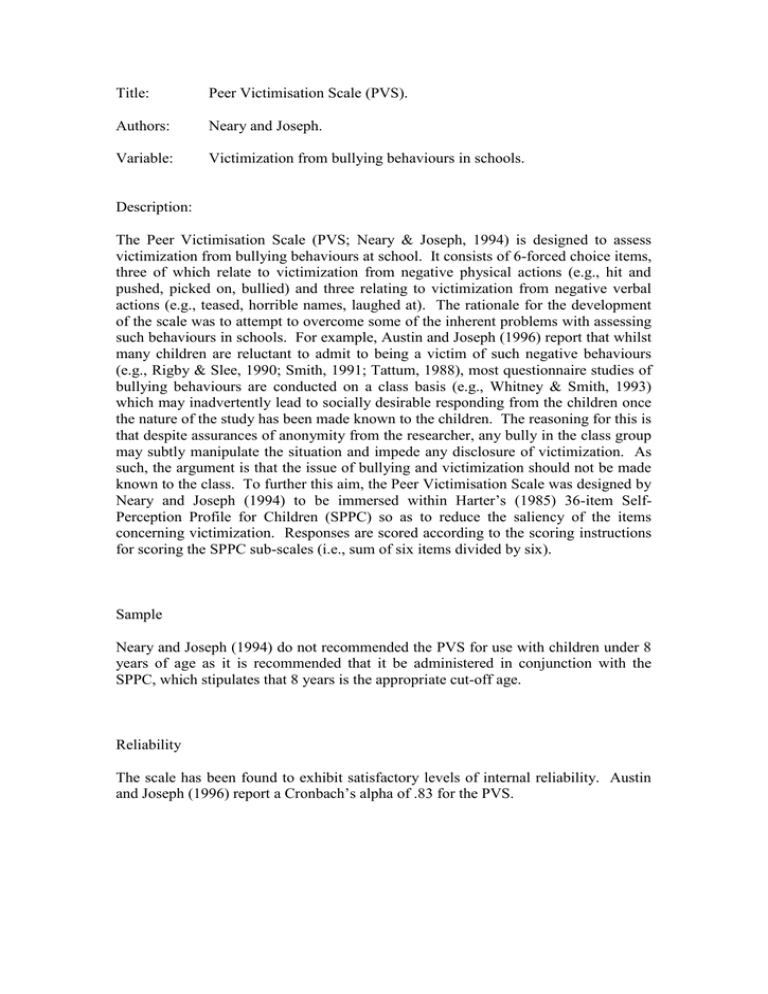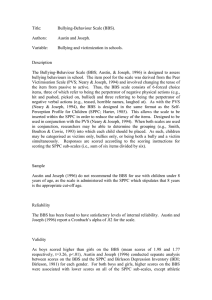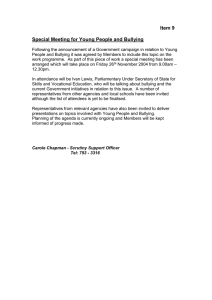Title: Peer Victimisation Scale (PVS). Authors:
advertisement

Title: Peer Victimisation Scale (PVS). Authors: Neary and Joseph. Variable: Victimization from bullying behaviours in schools. Description: The Peer Victimisation Scale (PVS; Neary & Joseph, 1994) is designed to assess victimization from bullying behaviours at school. It consists of 6-forced choice items, three of which relate to victimization from negative physical actions (e.g., hit and pushed, picked on, bullied) and three relating to victimization from negative verbal actions (e.g., teased, horrible names, laughed at). The rationale for the development of the scale was to attempt to overcome some of the inherent problems with assessing such behaviours in schools. For example, Austin and Joseph (1996) report that whilst many children are reluctant to admit to being a victim of such negative behaviours (e.g., Rigby & Slee, 1990; Smith, 1991; Tattum, 1988), most questionnaire studies of bullying behaviours are conducted on a class basis (e.g., Whitney & Smith, 1993) which may inadvertently lead to socially desirable responding from the children once the nature of the study has been made known to the children. The reasoning for this is that despite assurances of anonymity from the researcher, any bully in the class group may subtly manipulate the situation and impede any disclosure of victimization. As such, the argument is that the issue of bullying and victimization should not be made known to the class. To further this aim, the Peer Victimisation Scale was designed by Neary and Joseph (1994) to be immersed within Harter’s (1985) 36-item SelfPerception Profile for Children (SPPC) so as to reduce the saliency of the items concerning victimization. Responses are scored according to the scoring instructions for scoring the SPPC sub-scales (i.e., sum of six items divided by six). Sample Neary and Joseph (1994) do not recommended the PVS for use with children under 8 years of age as it is recommended that it be administered in conjunction with the SPPC, which stipulates that 8 years is the appropriate cut-off age. Reliability The scale has been found to exhibit satisfactory levels of internal reliability. Austin and Joseph (1996) report a Cronbach’s alpha of .83 for the PVS. Validity Neary and Joseph (1994) report that when the PVS was used in conjunction with the SPPC, it was able to discriminate well between bullied and non-bullied children on the basis of self and peer-reports. This finding was replicated by Callaghan and Joseph (1995), thus confirming the convergent validity of the PVS with self- and peer-reports of bullying behaviours. Neary and Joseph (1994) also reported that higher scores on the PVS were associated with lower scores on all of the SPPC sub-scales, except for athletic competence, and higher scores on the Birleson Depression Inventory (BDI; Birleson, 1981). In a replication of this work, Austin and Joseph (1996) found that higher scores on the PVS were associated with lower scores on all of the SPPC sub-scales and higher scores on the BDI for both boys and girls. Location Neary, A., & Joseph, S. (1994). Peer victimization and its relationship to self-concept and depression among schoolchildren. Personality and Individual Differences, 16, 183-186. Comments Although other questionnaires, such as the Bully/Victim Questionnaire (Olweus, 1978, 1991, 1993) are available to researchers interested in childhood bullying, the strength of the PVS is in its brevity and structure. By being designed to slot into the SPPC, this not only helps to reduce possible manipulation of testing situations by bullies, but reduces the saliency of the items and allows for less socially desirable responding from the children. A further strength is that when used in conjunction with the Bullying-Behaviour Scale (BBS; Austin & Joseph, 1996), which is similarly designed, assessments of categories of bullies and victims may be readily made. Overall, the PVS is a useful instrument for any researcher attempting to assess accurately the levels of victimization in large samples of children. Although other instruments may be useful in assessing the extent and frequency of bullying behaviours in schools, the PVS addresses a real need for a discreet measure of the extent of peer victimization from bullying behaviours. Publications Austin,S., & Joseph, S. (1996). Assessment of bully/victim problems in 8 to 11 yearolds. British Journal of Educational Psychology, 66, 447-456. Birleson, P. (1981). The validity of depression disorder in childhood and the development of a self-rating scale: a research report. Journal of Child Psychology and Psychiatry, 22, 73-88. Callaghan, S., & Joseph, S. (1995). Self-concept and peer victimization among schoolchildren. Personality and Individual Differences, 18, 161-163. Harter, S. (1985). The Self-Perception Profile for Children: Revision of the Perceived Competence Scale for Children - Manual. Denver, CO: University of Denver. Olweus, D. (1978). Aggression in the Schools: Bullies and Whipping Boys. Washington, DC: Hemisphere. Olweus, D. (1991). Bully/victim problems among schoolchildren: basic facts and effects of a school based intervention program. In D.Pepler & K. Rubin (Eds.), The Development and Treatment of Childhood Aggression, (pp. 411-448). Hillsdale, NJ: Erlbaum. Olweus, D. (1993). Bullying at School: What We Know and What We Can Do. Oxford: Blackwell. Rigby, K., & Slee, P.T. (1990). Victims and bullies in school communities. Journal of the Australian Society of Victimology, 1, 23-28. Smith, P.K. (1991).The silent nightmare: bullying and victimization in school peer groups. The Psychologist, 14, 243-248. Tattum, D.P. (1988). Violence and aggression in schools. In D.P. Tattum & D.A. Lane (Eds.), Bullying in Schools. Stoke-on-Trent: Trentham Books. Whitney, I., & Smith, P.K. (1993). A survey of the nature and extent of bullying in junior/middle and secondary schools. Educational Research, 35, 3-25. Reviewer Conor McGuckin, Christopher Alan Lewis, School of Psychology and Communication, University of Ulster at Magee College, Londonderry, Northern Ireland, BT48 7JL, U.K. CA.LEWIS@ULST.AC.UK





